You may have heard the MIPS assembly language is hard to learn. Or perhaps it seemed hard to you. Well this is completely false. Learning MIPS assembly is easy, putting it in practice whoever might be hard for a lot of people who have an undeveloped logical mind.
HEXADECIMAL AND BINARY
Now letís start with Hex.
Hex is a base 16 number system while Decimal is base 10.
While Decimal contains:
0, 1, 2, 3, 4, 5, 6, 7, 8, 9
Hex has 6 more:
0, 1, 2, 3, 4, 5, 6, 7, 8, 9, A, B, C, D, E, F
Conversion table
| Binary | Hex | Dec | Binary | Hex | Dec | Binary | Hex | Dec | Binary | Hex | Dec | |||
| 00000000 | 0x00 | 0 | 01000000 | 0x40 | 64 | 10000000 | 0x80 | 128 | 11000000 | 0xC0 | 192 | |||
| 00000001 | 0x01 | 1 | 01000001 | 0x41 | 65 | 10000001 | 0x81 | 129 | 11000001 | 0xC1 | 193 | |||
| 00000010 | 0x02 | 2 | 01000010 | 0x42 | 66 | 10000010 | 0x82 | 130 | 11000010 | 0xC2 | 194 | |||
| 00000011 | 0x03 | 3 | 01000011 | 0x43 | 67 | 10000011 | 0x83 | 131 | 11000011 | 0xC3 | 195 | |||
| 00000100 | 0x04 | 4 | 01000100 | 0x44 | 68 | 10000100 | 0x84 | 132 | 11000100 | 0xC4 | 196 | |||
| 00000101 | 0x05 | 5 | 01000101 | 0x45 | 69 | 10000101 | 0x85 | 133 | 11000101 | 0xC5 | 197 | |||
| 00000110 | 0x06 | 6 | 01000110 | 0x46 | 70 | 10000110 | 0x86 | 134 | 11000110 | 0xC6 | 198 | |||
| 00000111 | 0x07 | 7 | 01000111 | 0x47 | 71 | 10000111 | 0x87 | 135 | 11000111 | 0xC7 | 199 | |||
| 00001000 | 0x08 | 8 | 01001000 | 0x48 | 72 | 10001000 | 0x88 | 136 | 11001000 | 0xC8 | 200 | |||
| 00001001 | 0x09 | 9 | 01001001 | 0x49 | 73 | 10001001 | 0x89 | 137 | 11001001 | 0xC9 | 201 | |||
| 00001010 | 0x0A | 10 | 01001010 | 0x4A | 74 | 10001010 | 0x8A | 138 | 11001010 | 0xCA | 202 | |||
| 00001011 | 0x0B | 11 | 01001011 | 0x4B | 75 | 10001011 | 0x8B | 139 | 11001011 | 0xCB | 203 | |||
| 00001100 | 0x0C | 12 | 01001100 | 0x4C | 76 | 10001100 | 0x8C | 140 | 11001100 | 0xCC | 204 | |||
| 00001101 | 0x0D | 13 | 01001101 | 0x4D | 77 | 10001101 | 0x8D | 141 | 11001101 | 0xCD | 205 | |||
| 00001110 | 0x0E | 14 | 01001110 | 0x4E | 78 | 10001110 | 0x8E | 142 | 11001110 | 0xCE | 206 | |||
| 00001111 | 0x0F | 15 | 01001111 | 0x4F | 79 | 10001111 | 0x8F | 143 | 11001111 | 0xCF | 207 | |||
| 00010000 | 0x10 | 16 | 01010000 | 0x50 | 80 | 10010000 | 0x90 | 144 | 11010000 | 0xD0 | 208 | |||
| 00010001 | 0x11 | 17 | 01010001 | 0x51 | 81 | 10010001 | 0x91 | 145 | 11010001 | 0xD1 | 209 | |||
| 00010010 | 0x12 | 18 | 01010010 | 0x52 | 82 | 10010010 | 0x92 | 146 | 11010010 | 0xD2 | 210 | |||
| 00010011 | 0x13 | 19 | 01010011 | 0x53 | 83 | 10010011 | 0x93 | 147 | 11010011 | 0xD3 | 211 | |||
| 00010100 | 0x14 | 20 | 01010100 | 0x54 | 84 | 10010100 | 0x94 | 148 | 11010100 | 0xD4 | 212 | |||
| 00010101 | 0x15 | 21 | 01010101 | 0x55 | 85 | 10010101 | 0x95 | 149 | 11010101 | 0xD5 | 213 | |||
| 00010110 | 0x16 | 22 | 01010110 | 0x56 | 86 | 10010110 | 0x96 | 150 | 11010110 | 0xD6 | 214 | |||
| 00010111 | 0x17 | 23 | 01010111 | 0x57 | 87 | 10010111 | 0x97 | 151 | 11010111 | 0xD7 | 215 | |||
| 00011000 | 0x18 | 24 | 01011000 | 0x58 | 88 | 10011000 | 0x98 | 152 | 11011000 | 0xD8 | 216 | |||
| 00011001 | 0x19 | 25 | 01011001 | 0x59 | 89 | 10011001 | 0x99 | 153 | 11011001 | 0xD9 | 217 | |||
| 00011010 | 0x1A | 26 | 01011010 | 0x5A | 90 | 10011010 | 0x9A | 154 | 11011010 | 0xDA | 218 | |||
| 00011011 | 0x1B | 27 | 01011011 | 0x5B | 91 | 10011011 | 0x9B | 155 | 11011011 | 0xDB | 219 | |||
| 00011100 | 0x1C | 28 | 01011100 | 0x5C | 92 | 10011100 | 0x9C | 156 | 11011100 | 0xDC | 220 | |||
| 00011101 | 0x1D | 29 | 01011101 | 0x5D | 93 | 10011101 | 0x9D | 157 | 11011101 | 0xDD | 221 | |||
| 00011110 | 0x1E | 30 | 01011110 | 0x5E | 94 | 10011110 | 0x9E | 158 | 11011110 | 0xDE | 222 | |||
| 00011111 | 0x1F | 31 | 01011111 | 0x5F | 95 | 10011111 | 0x9F | 159 | 11011111 | 0xDF | 223 | |||
| 00100000 | 0x20 | 32 | 01100000 | 0x60 | 96 | 10100000 | 0xA0 | 160 | 11100000 | 0xE0 | 224 | |||
| 00100001 | 0x21 | 33 | 01100001 | 0x61 | 97 | 10100001 | 0xA1 | 161 | 11100001 | 0xE1 | 225 | |||
| 00100010 | 0x22 | 34 | 01100010 | 0x62 | 98 | 10100010 | 0xA2 | 162 | 11100010 | 0xE2 | 226 | |||
| 00100011 | 0x23 | 35 | 01100011 | 0x63 | 99 | 10100011 | 0xA3 | 163 | 11100011 | 0xE3 | 227 | |||
| 00100100 | 0x24 | 36 | 01100100 | 0x64 | 100 | 10100100 | 0xA4 | 164 | 11100100 | 0xE4 | 228 | |||
| 00100101 | 0x25 | 37 | 01100101 | 0x65 | 101 | 10100101 | 0xA5 | 165 | 11100101 | 0xE5 | 229 | |||
| 00100110 | 0x26 | 38 | 01100110 | 0x66 | 102 | 10100110 | 0xA6 | 166 | 11100110 | 0xE6 | 230 | |||
| 00100111 | 0x27 | 39 | 01100111 | 0x67 | 103 | 10100111 | 0xA7 | 167 | 11100111 | 0xE7 | 231 | |||
| 00101000 | 0x28 | 40 | 01101000 | 0x68 | 104 | 10101000 | 0xA8 | 168 | 11101000 | 0xE8 | 232 | |||
| 00101001 | 0x29 | 41 | 01101001 | 0x69 | 105 | 10101001 | 0xA9 | 169 | 11101001 | 0xE9 | 233 | |||
| 00101010 | 0x2A | 42 | 01101010 | 0x6A | 106 | 10101010 | 0xAA | 170 | 11101010 | 0xEA | 234 | |||
| 00101011 | 0x2B | 43 | 01101011 | 0x6B | 107 | 10101011 | 0xAB | 171 | 11101011 | 0xEB | 235 | |||
| 00101100 | 0x2C | 44 | 01101100 | 0x6C | 108 | 10101100 | 0xAC | 172 | 11101100 | 0xEC | 236 | |||
| 00101101 | 0x2D | 45 | 01101101 | 0x6D | 109 | 10101101 | 0xAD | 173 | 11101101 | 0xED | 237 | |||
| 00101110 | 0x2E | 46 | 01101110 | 0x6E | 110 | 10101110 | 0xAE | 174 | 11101110 | 0xEE | 238 | |||
| 00101111 | 0x2F | 47 | 01101111 | 0x6F | 111 | 10101111 | 0xAF | 175 | 11101111 | 0xEF | 239 | |||
| 00110000 | 0x30 | 48 | 01110000 | 0x70 | 112 | 10110000 | 0xB0 | 176 | 11110000 | 0xF0 | 240 | |||
| 00110001 | 0x31 | 49 | 01110001 | 0x71 | 113 | 10110001 | 0xB1 | 177 | 11110001 | 0xF1 | 241 | |||
| 00110010 | 0x32 | 50 | 01110010 | 0x72 | 114 | 10110010 | 0xB2 | 178 | 11110010 | 0xF2 | 242 | |||
| 00110011 | 0x33 | 51 | 01110011 | 0x73 | 115 | 10110011 | 0xB3 | 179 | 11110011 | 0xF3 | 243 | |||
| 00110100 | 0x34 | 52 | 01110100 | 0x74 | 116 | 10110100 | 0xB4 | 180 | 11110100 | 0xF4 | 244 | |||
| 00110101 | 0x35 | 53 | 01110101 | 0x75 | 117 | 10110101 | 0xB5 | 181 | 11110101 | 0xF5 | 245 | |||
| 00110110 | 0x36 | 54 | 01110110 | 0x76 | 118 | 10110110 | 0xB6 | 182 | 11110110 | 0xF6 | 246 | |||
| 00110111 | 0x37 | 55 | 01110111 | 0x77 | 119 | 10110111 | 0xB7 | 183 | 11110111 | 0xF7 | 247 | |||
| 00111000 | 0x38 | 56 | 01111000 | 0x78 | 120 | 10111000 | 0xB8 | 184 | 11111000 | 0xF8 | 248 | |||
| 00111001 | 0x39 | 57 | 01111001 | 0x79 | 121 | 10111001 | 0xB9 | 185 | 11111001 | 0xF9 | 249 | |||
| 00111010 | 0x3A | 58 | 01111010 | 0x7A | 122 | 10111010 | 0xBA | 186 | 11111010 | 0xFA | 250 | |||
| 00111011 | 0x3B | 59 | 01111011 | 0x7B | 123 | 10111011 | 0xBB | 187 | 11111011 | 0xFB | 251 | |||
| 00111100 | 0x3C | 60 | 01111100 | 0x7C | 124 | 10111100 | 0xBC | 188 | 11111100 | 0xFC | 252 | |||
| 00111101 | 0x3D | 61 | 01111101 | 0x7D | 125 | 10111101 | 0xBD | 189 | 11111101 | 0xFD | 253 | |||
| 00111110 | 0x3E | 62 | 01111110 | 0x7E | 126 | 10111110 | 0xBE | 190 | 11111110 | 0xFE | 254 | |||
| 00111111 | 0x3F | 63 | 01111111 | 0x7F | 127 | 10111111 | 0xBF | 191 | 11111111 | 0xFF | 255 |
You can be sure a number is in hex when it is preceded by 0x, or $ which are commonly used in programming communities:
0xFF, 0x024E, $A2
The most commonly used format in hex is a byte.
A byte is composed of 2 nibbles. Those nibbles are simply a character from 0 to F.
Those nibbles are composed of bits. While bits and Boolean are stored the exact same way, we use the term Boolean for a value that is either TRUE (1) or FALSE (0) and a bit is simply 1 or 0.
Value types
| Range of values | Type | Equivalent |
| 0-1 | Boolean/Bit | - |
| 0x0-0xF | Nibble | 4 bits |
| 0x00-0xFF | Byte | 8 bits |
| 0x0000-0xFFFF | Half-Word | 2 bytes |
| 0x00000000-0xFFFFFFFF | Word | 4 bytes |
| 0x0000000000000000-0xFFFFFFFFFFFFFFFF | Double-Word | 2 words |
There are others, but thatís not important for PSX hacking.
An important note about the Little Endian (the data format the PSX uses) is that the bytes are reversed. What this means is that the last byte in a value becomes the first. Note that this strictly depends of the value type; hence how the value is read/written. Note that the following examples show the stored values in hex display without 0x or $, which is because those characters would not only be confusing but would also take a lot of space. Whoever in person to person written conversations, 0x or $ should ALWAYS be used to avoid confusion with a decimal value.
Hex storage
| Hexadecimal Value | Is stored as |
| 0x78 | 78 |
| 0x011F | 1F 01 |
| 0x80050263 | 63 02 05 80 |
| 0x00000002846A0507 | 07 05 6A 84 02 00 00 00 |
Usually the game also reads/write bits this way.
The binary 10000000 represent 0x80 in hex. This ď1Ē will be the first bit to be loaded. In order it loads the value 0x80, 0x40, 0x20, 0x10, 0x08, 0x04, 0x02 and finally 0x01.
Booleans/Flags
| 0 | FALSE |
| 1 | TRUE |
Letís do a little hex conversion practice to help you understand better:
Example
| 0x02A7 to decimal (hex is base 16) |
| $00 ◊ 163 = 0 ◊ 4096 = 0
$02 ◊ 162 = 2 ◊ 256 = 512 $0A ◊ 161 = 10 ◊ 16 = 160 $07 ◊ 160 = 7 ◊ 1 = 7 0 + 512 + 160 + 7 = 679 |
| 0x02A7 = 679 |
STATIC VS DYNAMIC
A static value doesnít change, it is meant to be only loaded. All opcodes (which you will see later) are static. You COULD make some opcodes dynamic but this is seriously asking for trouble unless you are a high level hacker, perfectly sure of what youíre doing and know it will use less space (if that is even possible) than conventional coding.
Examples of static data: the WP of a weapon, the HPM of a job, the coordinates of a move-find item, etc.
A dynamic value is meant to be changed; therefore a new value will overwrite the previous one.
Examples of dynamic data:
HP of a unit, Max HP of a unit (base max HP calculated, different units, level up, etc.), total gil amount, etc.
A memory editor will help you finding dynamic data only. If you search for static data youíre better off using a simple hex editor. Using the memory editor you scan a first time inputting what you know of the value, change the value in game, and make another search with the known modifications to the value.
To search for static data, you can either guess what the data is for, or debug using breakpoints on the data.
SIGNED AND UNSIGNED
A signed variable can have half of its values positive, and the other half negative. How do we know if a value is signed or not? This all depends on how the value is read/written by opcodes.
Let me show you can example:
0x7F (maximum positive value of a signed byte) = 127
Nothing changed here. However:
0xFF = -1
Now Iíve got you confused. You see, while 0x7F is the highest positive value, the value right after which is 0x80 is the lowest negative value.
0x7F = +127
0x80 = -128
An unsigned byte (which is a normal byte) can have values from 0-255 (x00-xFF).
Letís to it with 0x9B
255+1 =256
0x9B Ė 256 = 155 Ė 256 = -101
a signed 0x9B = -101, an unsigned 0x9B = 155
Remember that the value will only be negative if it exceeds half of its maximum value.
Of course, the same applies to other variables, except bits.
Sign table
| Value | Unsigned | Signed |
| 0x70 | 112 | +112 |
| 0x9F | 159 | -97 |
| 0x03E7 | 999 | +999 |
| 0xFFB2 | 65458 | -78 |
| 0x000000FE | 254 | +254 |
| 0x80196804 | 2149148676 | -2145818620 |
OPCODES
Opcodes are the instructions executed by the consoleís processor. Since we started with hexadecimal and binary, weíll look into the bitwise operands first.
Opcodes will read/write registers depending on what it is supposed to do. Mainly we will work with conditional jumps (branches), jumps, load/write value (from/to memory), and everything else that alters a registerís value.
Many instructions have an immediate form, such as addiu (Add Immediate Unsigned) instead of addu (Add Unsigned). An immediate is a half-word value that is within the instruction itself and is static.
Some instructions have the variable form, such as SLLV (Shift Left Logical Variable) which is simply the register version of the SSL (which uses a 5 bit immediate).
A register is the type of data used by almost all instructions. They are words (so 4 bytes).
There are 32 main registers that are directly used by opcodes: r0, r1, r2, ... r31. r0 will always be 0x00000000 so you can use it to compare if a value is true or not safely.
Letís get on to bitwise operands:
AND
(And)
(And)
| AND returns TRUE to rd if both bits in rs and rt are TRUE. Else it returns FALSE. |
| AND rd, rs, rt [rd = rs AND rt]
AND rd, 0x00678460, 0x8005CE40 rs 00000000011001111000010001100000 0x00678460 rt 10000000000001011100111001000000 0x8005CE40 ---------------------------------------------- rd 00000000000001011000010001000000 0x00058440 |
| ANDI rt, rs, imm. [rt = rs AND imm.]
ANDI rd, 0x0000006B, 0x02C6 rs 00000000000000000000000001101011 0x0000006B im ∑∑∑∑∑∑∑∑∑∑∑∑∑∑∑∑0000001011000110 ∑∑∑∑0x02C6 ---------------------------------------------- rd 00000000000000000000000001000010 0x00000042 |
OR
(Or)
(Or)
| OR returns TRUE to rd if at least one of the bits in rs and rt are TRUE. Else it returns FALSE. |
| OR rd, rs, rt [rd = rs OR rt]
OR rd, 0x00057A46, 0x0C82 rs 00000000000001010111101001000110 0x00057A46 rt 00000000000000000000110010000010 0x00000C82 ---------------------------------------------- rd 00000000000001010111111011000110 0x00057EC6 |
| ORI rd, rs, imm. [rd = rs OR imm.]
ORI rd, 0x0000006B, 0x000002C6 rs 0000000000000000000000001101011 0x0000006B im ∑∑∑∑∑∑∑∑∑∑∑∑∑∑∑∑000001011000110 ∑∑∑∑0x02C6 --------------------------------------------- rd 0000000000000000000001011101111 0x000002EF |
SLL
(Shift Left Logical)
(Shift Left Logical)
| SLL shifts rt's bits to the left by sa bits and stores the result in rd.
Excessive bits will be destroyed. New bits are always FALSE. sa can hold a value from 0x00 to 0x1F inclusively. |
| SLL rd, rt, sa [rd = rt << sa]
SLL rd, 0x000008E4, 0x02 rt 00000000000000000000100011100100 0x000008E4 sa ∑∑∑∑∑∑∑∑∑∑∑∑∑∑∑∑∑∑∑∑∑∑∑∑∑∑∑00010 ∑∑∑∑∑∑0x02 ---------------------------------------------- rd 00000000000000000010001110010000 0x00002390 |
| SLLV rd, rt, sa [rd = rt << rs]
SLL rd, 0x0000008A, 0x00000004 rt 00000000000000000001010110001010 0x0000158A rs 00000000000000000000000000000100 0x00000004 ---------------------------------------------- rd 00000000000000010101100010100000 0x000158A0 |
SRL
(Shift Right Logical)
(Shift Right Logical)
| SRL shifts rt's bits to the right by sa bits and stores the result in rd.
Excessive bits will be destroyed. New bits are always FALSE. sa can hold a value from 0x00 to 0x1F inclusively. |
| SRL rd, rt, sa [rd = rt >> sa]
SRL rd, 0x000012C7, 0x07 rt 00000000000000000001001011000111 0x000012C7 sa ∑∑∑∑∑∑∑∑∑∑∑∑∑∑∑∑∑∑∑∑∑∑∑∑∑∑∑00111 ∑∑∑∑∑∑0x07 ---------------------------------------------- rd 00000000000000000000000000100101 0x00000025 |
| SRLV rd, rt, rs [rd = rt >> rs]
SRLV rd, 0x000000C3, 0x00000001 rt 00000000000000000000000011000011 0x000000C3 rs 00000000000000000000000000000000 0x00000001 ---------------------------------------------- rd 00000000000000000000000001100001 0x00000061 |
A few mathematic functions can be applied to registers. Many of them have a signed/unsigned version so make sure you choose the right one depending on your needs.
some of them also uses the hi(high) and lo(low) registers. Basically you cannot use those registers directly as they are not part of the 32 first registers.
However you can still move a value/from to those registers in your hacks to store temporarly a value, which can be extremely useful in some cases if you want to avoid loading/writing to the game's memory.
Here are some mathematical functions:
ADD
(Add)
(Add)
| ADD will add the value, positive or negative, of rs to rt and store the result in rd. |
| ADD rd, rs, st [rd = rs + rt]
ADD rd, 0x8005A48C, 0x000002B0 rs 10000000000001011010010010001100 0x8005A48C rt 00000000000000000000001010110000 0x000002B0 ---------------------------------------------- rd 10000000000001011010011100111100 0x8005A73C |
| ADDU rd, rs, st [rd = rs + rt]
ADDU rd, 0x00000034, 0x80067F80 rs 00000000000000000000001000110100 0x00000234 rt 10000000000001100111111110000000 0x80067F80 ---------------------------------------------- rd 10000000000001101000000110110100 0x800681B4 |
| ADDI rd, rs, imm. [rd = rs + imm.]
ADDI rd, 0x0000187E, 0xFFE2 rs 00000000000000000001100001111110 0x0000187E im ∑∑∑∑∑∑∑∑∑∑∑∑∑∑∑∑1111111111100010 ∑∑∑∑0xFFE2 ---------------------------------------------- rd 00000000000000000001100001100000 0x00001860 |
| ADDIU rd, rs, imm. [rd = rs + imm.]
ADDIU rd, 0x0074FF80, 0xC800 rs 00000000011101001111111110000000 0x0074FF80 im ∑∑∑∑∑∑∑∑∑∑∑∑∑∑∑∑0000000011001000 ∑∑∑∑0xC800 ---------------------------------------------- rd 00000000011101010000000001001000 0x00750048 |
SUB
(Subtract)
(Subtract)
| SUB will subtract from rs the value of rt and store the result in rd. |
| SUB rd, rs, st [rd = rs - rt]
SUB rd, 0x00000000, 0x00000000 rs 00000000000000000000000000000000 0x00000000 rt 00000000000000000000000000000000 0x00000000 ---------------------------------------------- rd 00000000000000000000000000000000 0x00000000 |
| SUBU rd, rs, st [rd = rs - rt]
SUBU rd, 0x00000000, 0x00000000 rs 00000000000000000000000000000000 0x00000000 rt 00000000000000000000000000000000 0x00000000 ---------------------------------------------- rd 00000000000000000000000000000000 0x00000000 |
ASM Hacking & Debugging with pSX
In this example we're going to edit the formula 0x53, which is originally:
Dmg_(Y%) Hit_(MA+X%)
and transform it into
Dmg_(PA*Y) Hit_(MA+X%)
Because of lazyness and the lack of zodiac compatibility already present in the formula, the outcome of this tutorial will be perfect damage.
This means the damage cannot be increased or lowered in any way. This is only an example.
First let's set a dummy ability for testing. The skill of choice, is as always, Cure. Make a new fresh PSX patch.
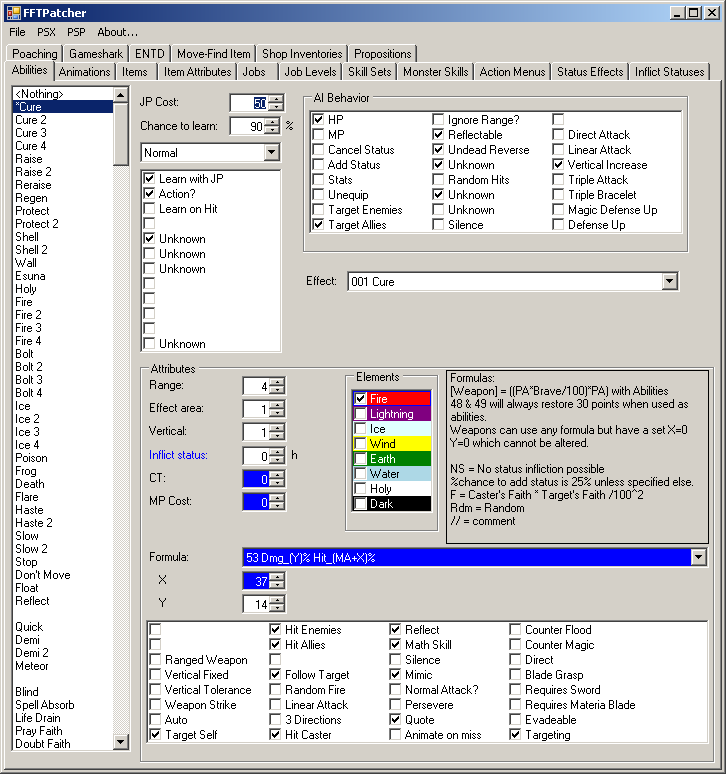
Now that you have made your changes, go to the gameshark tab and note the addresses, which means the first part of the address. The other half is unimportant for now.

Open the debugger and the memory window. Now head to your first address. To do that, press ctrl+g when the memory address is active, and type 0x5FC05.

Now enter the values manually. Remember, a gameshark code starting with "3" affects ONE byte, while a gameshark code starting with "8" affects TWO bytes. DON'T FORGET TO FLIP YOUR BYTES!!

Just checking if you did it right:
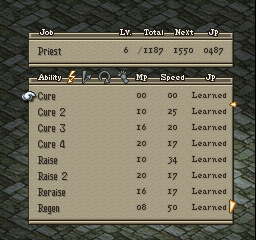
http://www.ffhacktics.com/wiki/Quick_References
Concerning unit stats
OK, a bit ugly, but you'll get the idea.
# Player unit 1 : 0x801924CC : Malak
# Player unit 2 : 0x8019268C : Rafa
# Player unit 3 : 0x8019284C : Meliadoul
# Player unit 4 : 0x80192A0C : Hyudra
# Player unit 5 : 0x80192BCC : Orlandu
It's always better to know your unit IDs before entering the battle, it saves searching time.
Too bad this won't be of any use in this tutorial, but it's very good to know.
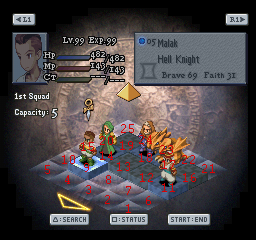
Now take your unholy cure spell and prepare to target someone, make a quicksave here.
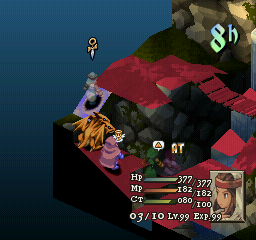
Time to add a breakpoint. To do this, right click inside the breakpoint window.
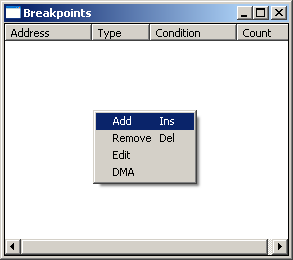
It will be Cure's Y value. It will be read and stored before the formula uses it. You can use FFTPatcher to get the memory address again if you forgot it.
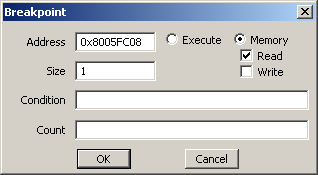
If you look carefully, the byte is loaded and stored again. It was coded this way to always have the X/Y value and other stuff used in a formula at a static location. We simply have to check its next destination, which is 0x801938FA.
This will be our new breakpoint. So edit it.

I made a square to delimitate the formula routine. It's pretty simple, like anything, it starts after another routine ends (after the jr r31) and ends with one.
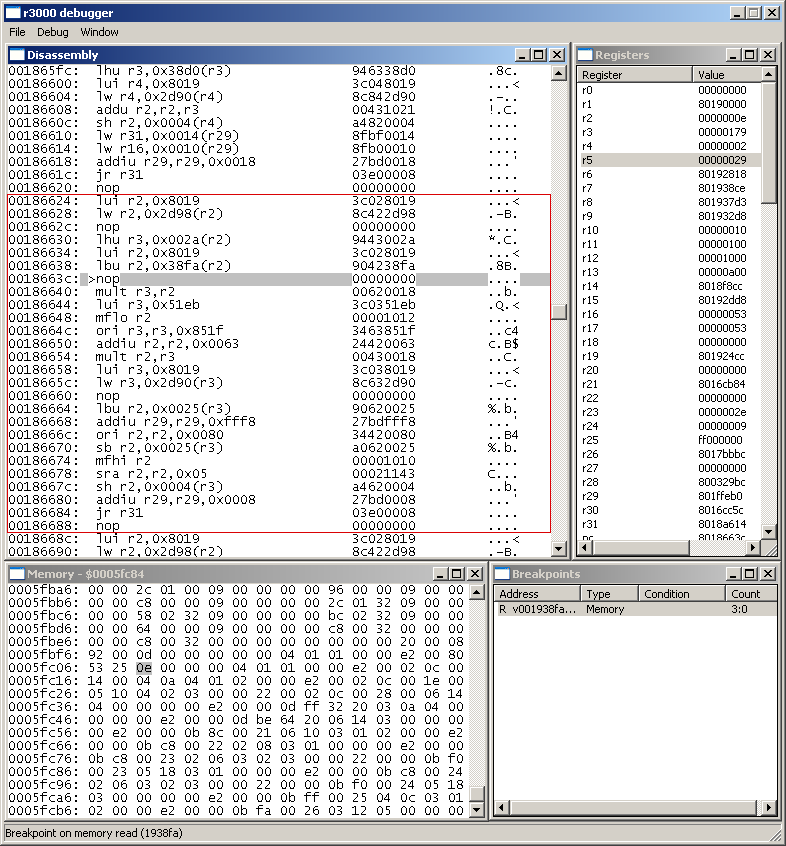
00186624: 3c028019 lui r2,0x8019
00186628: 8c422d98 lw r2,0x2d98(r2)
0018662c: 00000000 nop
>> r2 = Target's stat offset (see http://www.ffhacktics.com/wiki/Formula_Hacking)
00186630: 9443002a lhu r3,0x002a(r2)
>> r3 = Target's Max HP (see http://www.ffhacktics.com/wiki/Formula_Hacking)
00186634: 3c028019 lui r2,0x8019
00186638: 904238fa lbu r2,0x38fa(r2)
0018663c: 00000000 nop
>> r2 = Current ability's "Y"
00186640: 00620018 mult r3,r2
00186644: 3c0351eb lui r3,0x51eb
00186648: 00001012 mflo r2
0018664c: 3463851f ori r3,r3,0x851f
00186650: 24420063 addiu r2,r2,0x0063
00186654: 00430018 mult r2,r3
>> Some complex stuff to calculate % and round up
00186658: 3c038019 lui r3,0x8019
0018665c: 8c632d90 lw r3,0x2d90(r3)
00186660: 00000000 nop
00186664: 90620025 lbu r2,0x0025(r3)
00186668: 27bdfff8 addiu r29,r29,0xfff8
0018666c: 34420080 ori r2,r2,0x0080
00186670: a0620025 sb r2,0x0025(r3)
>> store r2 = Some value for later use?
00186674: 00001010 mfhi r2
>> r2 = calculated % HP damage
00186678: 00021143 sra r2,r2,0x05
0018667c: a4620004 sh r2,0x0004(r3)
>> r2 = r2 divided by 32
00186680: 27bd0008 addiu r29,r29,0x0008
>> no idea
00186684: 03e00008 jr r31
00186688: 00000000 nop
>> Jump return
now let's code some asm to convert Y% damage to PA*Y:
.org 0x80186640
lui r3, 0x8019
lw r3, 0x2D94
lbu r3, 0x0036(r3) (see http://www.ffhacktics.com/wiki/Formula_Hacking)
>> r3 = Caster's PA
mult r2, r3
>> Caster's PA * Y
Now you need to compile this code. Personally I use Renegade64 because I have no idea what other program can compile MIPS r3000.
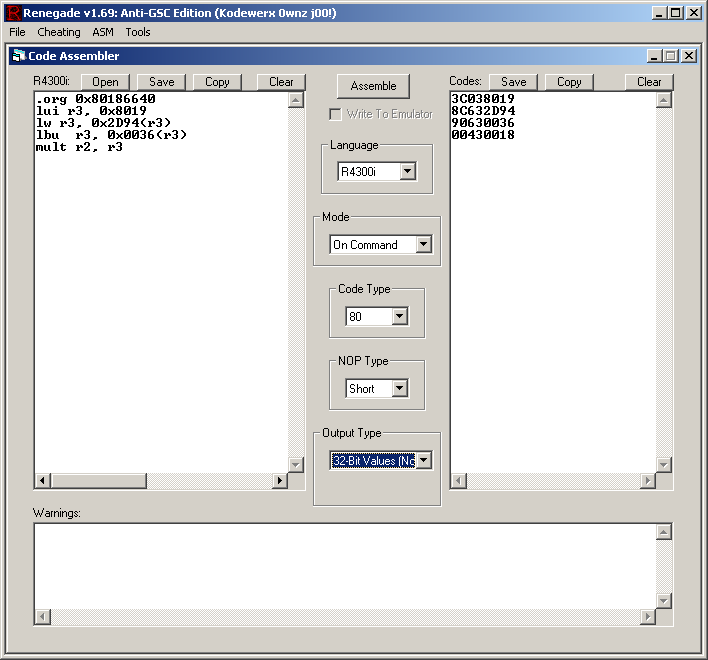
And you need to flip the bytes because Renegade compiled that way... yes, it's a lot of trouble but we don't have much other choice. If you're good with excel you can save some time, unless you really don't have much opcodes like this one.
3C038019
8C632D94
90630036
00430018
becomes
1980033C
942D638C
36006390
18004300
We also need to change "mfhi r2" to "mflo r2"
We should also fill everything else that affects r2 with nop (0x00000000).
Our memory hack should look like this:
0x80186640
1980033C
942D638C
36006390
18004300
00000000
00000000
0x80186674
12100000
00000000
Now to test it, the best way is to use winhex and use your savestate right before taking the action.
However, very often the addresses in quicksaves are 0x02B0 higher than memory addresses.
Meaning you will have to paste your data at:
0x80186640 > 1868F0
and
0x00186678 > 186928
Note that winhex doesn't support "0x" in front of hex. Now load your savestate, make sure you are in hex mode. If you aren't, click the address column.
Press alt+g and enter 1868F0. OK.
Now copy/write the new code. To write, press ctrl+b. It's like paste but it will simply overwrite the present data instead of moving it onwards.
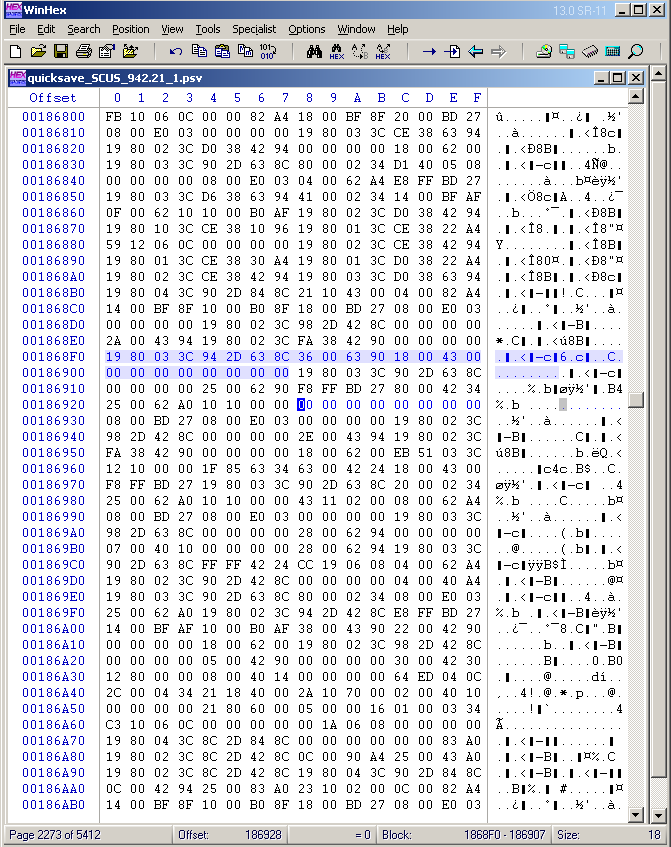
Load your savestate.
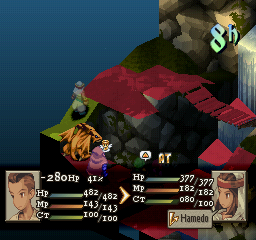
Test.

Victoly!
Now since this is only a formula hack, converting the addresses to BATTLE.BIN is easy. Just subtract 0x67000.
Here's the final Hack:
BATTLE.BIN
0x0011F640
1980033C
942D638C
36006390
18004300
00000000
00000000
0x0011F674
12100000
00000000
